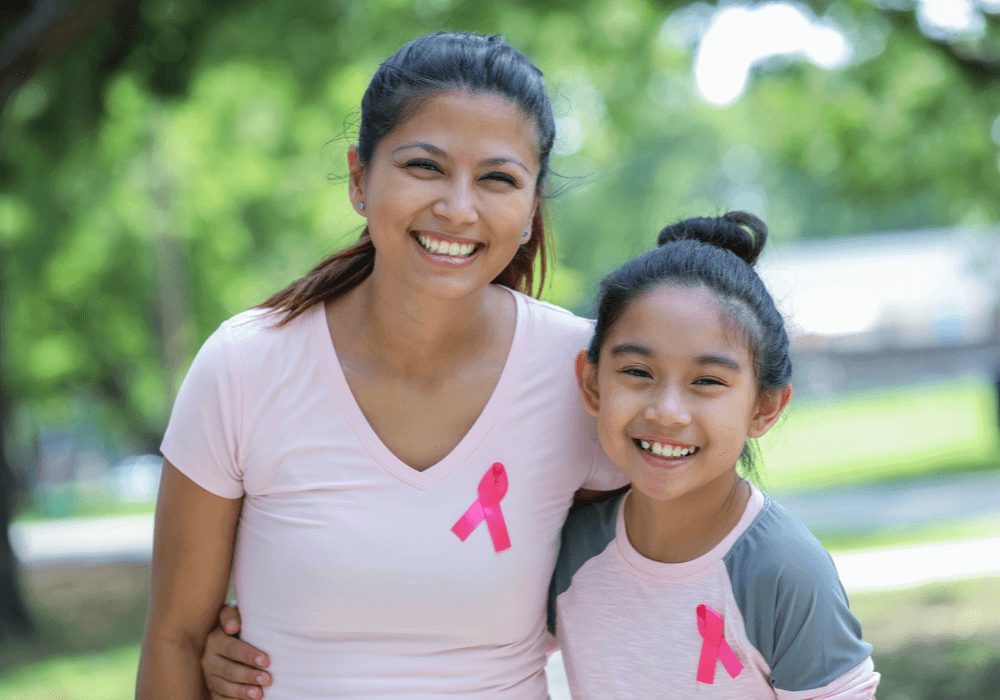October is Breast Cancer Awareness Month: Here’s What You Should Know

Every year, 245,000 women are diagnosed with breast cancer, the second most common cancer in women, and more than 40,000 women die from the disease, according to the CDC. While breast cancer is far more common in women – 99% of the cases plaguing the population are in women – it can also affect men. As October is Breast Cancer Awareness Month, we want to ensure that you’re aware of the risk factors that could lead to breast cancer, the symptoms associated with it, and how to decrease your chances of a diagnosis.
What is Breast Cancer?
Breast cancer is a disease where the cells in the breasts grow out of control. There are different types of breast cancer and the type is dependent upon which cells in the breast become cancerous.
Where does breast cancer form?
Breast cancer can begin in different parts of the breasts but most commonly it forms in the milk ducts, the tubes that deliver milk to the nipples. Cancer may also form in the lobules, which are the glands that produce the milk. Breast cancer can spread outside the breast through blood vessels and lymph vessels.
Know the symptoms of breast cancer
Different people that are diagnosed with breast cancer may experience different symptoms while some may experience none at all. Some symptoms commonly associated with breast cancer include:
- Nipple inversion or pain in the nipple area.
- Redness or flaky skin in the nipple area or the breast.
- Discharge from the nipple other than breast milk; this includes blood.
- Changes in the size or shape of the breast.
- Irritation or dimpling of breast skin.
- A new lump in the breast or armpit.
- Thickening or swelling of part of the breast.
- Pain in any area of the breast.
While some of these symptoms could be associated with a condition that is not cancer, if you have any signs or symptoms that worry you, schedule an appointment with your doctor right away.
Reduce your risk for breast cancer
Your risk for breast cancer is due to a combination of factors, where the main ones that increase your risk include being a woman and getting older. Most breast cancers are found in women that are 50 or older while about 10% of new breast cancer cases are found in women younger than 45. Many factors over your lifetime can affect your breast cancer risk, some that you have no control over, your family history or age for example, while you have the ability to lower your risk by taking care of your health.
Breast cancer risk factors you cannot control
- Aging: The risk of breast cancer increases as you age with most breast cancers diagnosed after the age of 50.
- Menstrual cycle history: Women whose menstrual cycles started before age 12 and those who started menopause after age 55 have a higher risk of breast cancer because they are exposed to hormones longer.
- Family history of breast cancer: The risk for breast cancer is higher if a woman’s mother, sister, or daughter or if multiple distant relatives on either parent’s side have had breast cancer.
- Personal history of breast cancer or other non-cancerous breast diseases: Women who have had a history of breast cancer are more likely to get breast cancer a second time.
- Previous radiation therapy treatment: Women who have had radiation therapy on their breasts or chest before the age of 30 have a higher risk of breast cancer later in life.
- Having dense breasts: Dense breasts means a woman has more connective tissue than fatty tissue which makes it more difficult to detect tumors on a mammogram.
- Genetic mutations: Women who have inherited genetic mutations to certain genes such as BRCA1 and BRCA2 have a higher likelihood of being diagnosed with breast and ovarian cancer.
- Women who took the drug diethylstilbestrol (DES): DES was a drug given to pregnant women between 1940 and 1971 to prevent miscarriage. Women who took it or whose mothers took it while pregnant with them have a higher risk of breast cancer.
Breast cancer risk factors you can control
- Maintain a healthy weight and exercise regularly, particularly after menopause.
- Breastfeeding your children lowers your risk of a breast cancer diagnosis.
- Getting pregnant for the first time after age 30, not breastfeeding, and never having a full-term pregnancy can raise breast cancer risk.
- External hormones like birth control pills, oral contraceptives, and hormone replacement therapy have been found to raise breast cancer risk. Ask your doctor about the risks to find the best solution for you.
- Drinking alcohol increases the risk of breast cancer. Limit alcohol intake to one drink a day or less.
Get breast cancer screenings regularly
As we stated earlier, some women who are diagnosed with breast cancer don’t experience any symptoms at all, making it that much more vital that you get regular breast cancer screenings. A breast cancer screening involves checking a woman’s breasts for cancer before signs or symptoms of the disease manifest themselves. It does not prevent breast cancer but it can assist in finding breast cancer early and early detection makes it easier to treat. Talk to your doctor about the best time to start getting regular breast cancer screenings and which test is best for you.